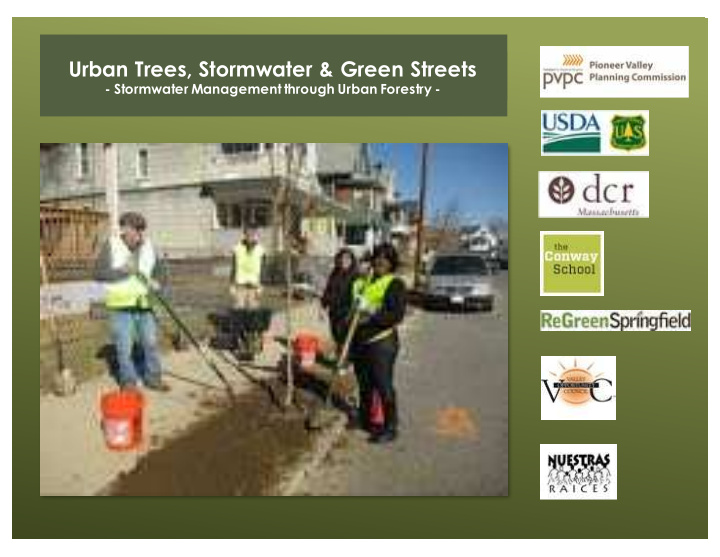



Urban Trees, Stormwater & Green Streets - Stormwater Management through Urban Forestry -
TONIGHT’S DISCUSSION TOPICS Urban Forests, Trees and • Watersheds The Urban Tree Canopy • An Introduction to Green Streets • Trees, More Trees and the Tree • Owners Manual
Table of Contents ______________________________ What Trees Do Benefits of the Urban Forest Components of a Watershed Urban Tree Canopy (UTC) Benefits of Green Streets Green Infrastructure Tools Tree Selection & Placement Planting Your Tree Properly Pruning Young Trees
• Aesthetics • Screening • Clean Air • Reduce Runoff and Erosion • Temper Climate • Save Energy • Create Wildlife Habitat • Improve Health • Emotional Well Being • Strengthen Community • Economic Values
DID YOU KNOW? Trees give us oxygen, clean the air, and filter airborne pollutants. • Trees conserve energy. Just three strategically placed trees can • decrease utility bills by 50%. Urban trees in the U.S. remove 711,000 tons of air pollution annually, at a • value of $3.8 billion. Trees and vegetation can raise property values up to 37%. • Trees can reduce annual storm water runoff by 2% – 7%. • The net cooling effect of a healthy tree is equivalent to 10 room-size air • conditioners operating 20 hours a day.
DID YOU KNOW? Trees clean the air by absorbing carbon dioxide, sulfur dioxide, • nitrous oxides and other pollutants. Trees shade cars and parking lots, reducing ozone emissions from • vehicles. Trees filter airborne pollutants and reduce the conditions that cause • asthma and other respiratory problems. Get trees. Get healthy. Children and youth living in greener • neighborhoods have lower body mass index. Trees reduce noise pollution by absorbing sounds. • Urban trees in the U.S. store 700 million tons of carbon valued at $14 • billion with an annual carbon sequestration rate of 22.8 million tons per year valued at $460 million annually.
HOW DO TREES BREATHE ? ! In leaves, water combines with carbon dioxide and sunlight to make sugar — food for the tree. During this process, called photosynthesis , the tree also produces oxygen. ! Oxygen and water then evaporate through the leaves — a process called transpiration . ! This is how a tree breathes.
HOW DO TREES DRINK? ! Water in the soil passes into tiny hairlike roots. It enters the root loaded with minerals from the soil, and is carried up the tree’s trunk all the way to the leaves.
ROOTS DO MORE THAN DRINK…
HOW MUCH WATER DOES A TREE DRINK? ! A healthy 100-foot-tall tree has about 200,000 leaves. A tree this size can take 11,000 gallons of water from the soil and release it into the air again, as oxygen and water vapor, in a single growing season.
STREAM SIDE BUFFER ! Leaving stream and river banks as natural as possible — with the soil undisturbed and covered with trees, shrubs, wildflowers, mosses and ferns — helps prevent erosion. ! A stream bottom filled with pebbles — rather than a dirt-filled bottom — is one sign of a healthy stream.
URBANIZING WATERSHEDS ! Increased ! Impervious Surfaces ! Roads, roofs, pools, sidewalks, parking lots ! Storm water ! Flash Flooding ! Peak Flow ! Floodplain development
IMPACT OF STORMWATER & IMPERVIOUS AREA ! More Extreme Droughts ! Lower Low Stream Flows ! More Frequent & Severe Flooding ! Less Groundwater Recharge ! Water Quality Impacts
THE URBAN STORM HYDROGRAPH å GREATER PEAKS & VOLUME Urban Urban&vs&Forested& Storm&Hydrographs& 400 350 300 Flow&Rate 250 Forested 200 150 100 50 0 0 2 4 6 8 10 12 14 16 Time
GOALS OF GREEN STREETS • Greening & Urban Beautification • Canopy Cover • Urban Heat Island Mitigation • Habitat & Food for Wildlife • Traffic Calming
OFFERING A SOLUTION TO URBAN STORMWATER GREEN STREETS Streets comprise a significant percentage of publicly owned • land in most communities, thereby offering a unique opportunity to incorporate green street elements that will not only protect the environment, but can improve community health and prosperity. Green streets incorporate a wide variety of design elements • including street trees, permeable pavements, bioretention, and swales. Successful application of green techniques will encourage soil and vegetation contact and infiltration and retention of stormwater.
BENEFITS OF GREEN STREETS TREES ARE GOOD FOR THE ENVIRONMENT – ECOSYSTEM SERVICES ! TREES ARE GOOD FOR BUSINESSES ! TREES ARE GOOD FOR OUR NEIGHBORHOODS ! TREES ARE GOOD FOR THE ECONOMY !
BENEFITS OF GREEN STREETS HAPPIER AND HEALTHIER RESDIENTS ! TREES HEAL AND HELP YOU LIVE LONGER! ! TREES MAKE FOR A SAFER COMMUNITY ! TREES ADD ECONOMIC V ALUE TO A COMMUNITY ! TREES ADD TO PRIDE OF PLACE AND NEIGHBORHOOD PRIDE !
GREEN PARKING LOTS
GREEN PARKING LOTS
NYC GREEN STREETS 111 th Street, Queens
NYC GREEN STREETS Cross Bronx Expwy & Fulton Ave, Bronx
NYC GREEN STREETS 10 th Ave & 14 th St, Manhattan
NYC GREEN STREETS Waldo & Greystone Aves, Bronx
NYC GREEN STREETS Amboy Rd & Richmond Valley Rd, Staten Island
NYC GREEN STREETS Nashville, Blvd., Manhattan
NYC GREEN STREETS Nashville, Blvd., Manhattan
STORMWATER CAPTURE TOOLS Pipe&Inlets Surface&Edging Trench&Drains Curb&Inlets Deep&Excavation Bioswale&Grading
GREEN INFRASTRUCTURE TOOLS BIOSWALE)(WITH)TREES): A)bioswale is)a)linear)vegetated) swale)that)channels)stormwater,) infiltrating)and)filtering)it)with) vegetation)and)soils)as)it)travels.
GREEN INFRASTRUCTURE TOOLS BREAK&OUT : BreakEouts)are)excavated)areas) filled)with)structural)soil,)often) under)sidewalks)or)roads.) Used)in)combination)with)other) green)infrastructure)tools)such)as) tree)trenches)or)stormwater planters,)breakEouts)provide)more) room)for)tree)roots)to)grow)in)tight) spaces,)increasing)the)longevity) and)survival)rate)of)urban)trees.
COVERED TREE TRENCH: A)covered)tree)trench)is)a)linear) system)of)trees)connected)by) structural)soil)underground)and) covered)with)permeable)pavers.) Stormwaterflows)into)the)trench) via)inlets)or)runnels)and)through) the)permeable)pavers,)infiltrating) into)the)soil.)The)continuous)mass) of)soil)combined)with)soil)breakE outs)under)sidewalks)and)streets) gives)roots)more)room,)increasing) vitality.
OPEN,TREE,TRENCH: like a covered tree trench, an open tree trench is a linear system of trees connected by structural soil underground, but it is filled with vegetation, not covered with permeable pavers. Stormwater flows into the trench via inlets and infiltrates into the soil. The continuous mass of soil in combination with soil break-outs into sidewalks and streets gives roots more room, increasing vitality.
WHY PRUNE YOUR TREES
PRUNING TOOLS
ESTABLISHING A STRONG SCAFFOLD STRUCTURE
PRUNING YOUNG TREES Making the Cut 1. Bottom Cut 2. Top cut 3. Finish cut
Recommend
More recommend